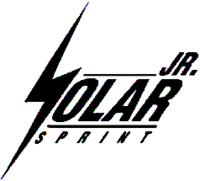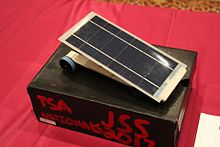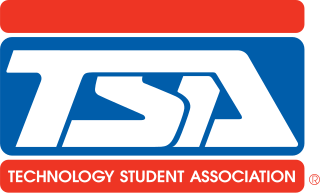
The Technology Student Association (TSA) is a national student organization created to develop skills in science, technology, engineering, and mathematics (STEM) and business education. TSA's aim is to develop leadership, academic, and business management skills in the workplace among students and leaders within the community. The organization has over 300,000 members.

A solar vehicle or solar electric vehicle is an electric vehicle powered completely or significantly by direct solar energy. Usually, photovoltaic (PV) cells contained in solar panels convert the sun's energy directly into electric energy.
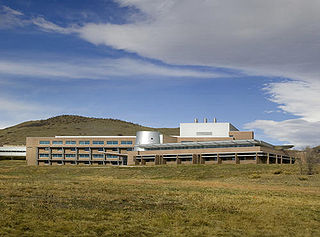
The National Renewable Energy Laboratory (NREL) in the US specializes in the research and development of renewable energy, energy efficiency, energy systems integration, and sustainable transportation. NREL is a federally funded research and development center sponsored by the Department of Energy and operated by the Alliance for Sustainable Energy, a joint venture between MRIGlobal and Battelle. Located in Golden, Colorado, NREL is home to the National Center for Photovoltaics, the National Bioenergy Center, and the National Wind Technology Center.

The American Solar Challenge (ASC), previously known as the North American Solar Challenge and Sunrayce, is a solar car race across the United States. In the race, teams from colleges and universities throughout North America design, build, test, and race solar-powered vehicles in a long distance road rally-style event. ASC is a test of teamwork, engineering skill, and endurance that stretches across thousands of miles of public roads.

The University of Calgary Solar Car Team is a multi-disciplinary student-run solar car racing ("raycing") team at the University of Calgary, based in Calgary, Alberta, Canada. It was established to design and build a solar car to compete internationally in the American Solar Challenge (ASC) and the World Solar Challenge (WSC). The team is primarily composed of undergraduate students studying Engineering, Business, Science, Arts and Kinesiology. The mission of the University of Calgary Solar Car Team is to educate the community about sustainable energy and to serve as an interdisciplinary project through which students and faculty from various departments can collaborate in supporting sustainable energy.
Crowder College is a public community college in Neosho, Missouri. It serves the Community College District of Newton and McDonald counties in southwestern Missouri and other outlying areas. The school enrolled 4,398 in 2019.

The University of Minnesota Solar Vehicle Project, or UMNSVP, is a team of undergraduate students from the University of Minnesota that designs and constructs solar-powered cars. In its 31 years, it has established itself as one of the world's top solar racing teams, and the top Cruiser/Multi-Occupant Vehicle team in the Western Hemisphere, with top-two finishes in eighteen of thirty-four events entered.
Durham University Solar Car, formerly Durham University Electric Motorsport, is a student-run team in the United Kingdom that designs and constructs solar powered cars to compete in international competitions. It is the longest running solar car team in the UK and is financed entirely by third party donations and sponsorship.
The Office of Energy Efficiency and Renewable Energy (EERE) is an office within the United States Department of Energy. Formed from other energy agencies after the 1973 energy crisis, EERE is led by the Assistant Secretary of Energy Efficiency and Renewable Energy, who is appointed by the president of the United States and confirmed by the U.S. Senate. Alejandro Moreno currently leads the office as the Acting Assistant Secretary.

The Victorian Model Solar Vehicle Challenge is a competition held annually at Scienceworks in Melbourne, Australia. The challenge gives school age children a chance to design and build a car or boat, and more recently a Mars Rover, that operates solely on solar power. It is run by MSV, a voluntary organisation created to administer the challenge.

The Sasol Solar Challenge is a South African endurance challenge for solar-powered vehicles, with classes for hybrid vehicles, electric vehicles, and biofuel-powered vehicles as well. Recognised by the International Solarcar Federation, the first challenge was run in 2008, and every two years thereafter. The event covers roughly 2,500 km, but has set loops for teams to repeat, with the potential to do 5,000 km. The current record, held by Dutch team Nuon, is 4,716 km, set in 2016 in their car Nuna. The challenge route may change from year to year. In 2022, it ran from Carnival City near Johannesburg to Cape Town over the course of 8 days. The challenge has both local South African teams from both high schools and universities participate, as well as some top-ranking international teams from Japan (Tokai), Belgium and the Netherlands.

A solar car is a solar vehicle for use on public roads or race tracks. Solar vehicles are electric vehicles that use self-contained solar cells to provide full or partial power to the vehicle via sunlight. Solar vehicles typically contain a rechargeable battery to help regulate and store the energy from the solar cells and from regenerative braking. Some solar cars can be plugged into external power sources to supplement the power of sunlight used to charge their battery.
Green jobs are, according to the United Nations Environment Program, "work in agricultural, manufacturing, research and development (R&D), administrative, and service activities that contribute(s) substantially to preserving or restoring environmental quality. Specifically, but not exclusively, this includes jobs that help to protect ecosystems and biodiversity; reduce energy, materials, and water consumption through high efficiency strategies; de-carbonize the economy; and minimize or altogether avoid generation of all forms of waste and pollution." The environmental sector has the dual benefit of mitigating environmental challenges as well as helping economic growth.
Solar car racing refers to competitive races of electric vehicles which are powered by solar energy obtained from solar panels on the surface of the car. The first solar car race was the Tour de Sol in 1985 which led to several similar races in Europe, US and Australia. Such challenges are often entered by universities to develop their students' engineering and technological skills, but many business corporations have entered competitions in the past. A small number of high school teams participate in solar car races designed exclusively for high school students.

The Tour de Sol in Switzerland was the first rally for solar powered vehicles. It was carried out annually from 1985 to 1993. The first event started on June 25 in Romanshorn on the Lake of Constance, and finished on June 30 in Geneva. 72 vehicles started in two classes; over 50 finished. The vehicles were powered exclusively by direct onboard solar power in addition to an initial charge of the onboard accumulators. The second class also allowed direct human power with pedals. The rally was conceived as a kind of race with the winners being those using the least time to travel the set course each day. The course was on unclosed public roads and the drivers were required to adhere all traffic rules and speed limits. The first events were very popular with thousands of spectators lining the roads and visiting the camps where the vehicles stopped each day. In later years the fastest vehicles also raced on round-circuit closed-off courses each day after arriving at the stops. From 1990 the organisers also held separate events called Tour de Sol Alpine. These included closed courses on frozen lakes and snowy roads and on unclosed mountain passes.
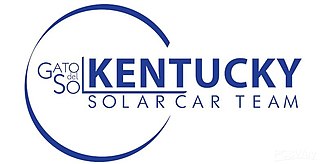
The University of Kentucky Solar Car Team is an independent, student-led project that operates as part of the University of Kentucky College of Engineering. The team's primary goal is to compete in the American Solar Challenge and the Formula Sun Grand Prix over the summer, but they also perform outreach events in which they display and discuss their car with nonmembers.
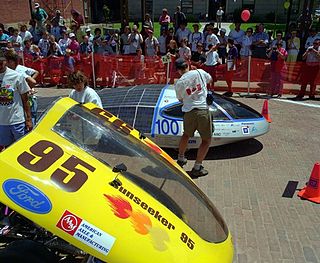
The Sunseeker Solar Car Project, Sunseeker for short, is Western Michigan University's solar car team. Each vehicle is designed, built, maintained, and raced by students. Sunseeker has competed in all of the American Solar Challenge events, going back to 1990.
Cambridge University Eco Racing (CUER) is one of UK's solar car racing teams. A team of 60 Cambridge students designs, builds and races solar-powered vehicles. Founded in 2007, their first prototype vehicle, Affinity, became the first solar-powered car to drive legally on UK roads. CUER competes in the biennial World Solar Challenge. Their race vehicle for the 2013 race, Resolution, is known for its innovative tracking plate design and unusual teardrop shape. Evolution, builds upon this previous design and was entered into the 2015 race, where it became the best UK entry since 2007. In 2017, CUER built Mirage, which crashed before the race had begun due to "a sudden loss of dynamic stability". CUER switched from Challenger Class to Cruiser Class in 2019, however, early electrical issues prevented the team from progressing beyond the first stage of the race.
The North Carolina Solar Center is a resource center for sustainable energy programs located at North Carolina State University in Raleigh, North Carolina. When it was created in 1988, the center's focus was solar energy. The N.C. Solar Center now serves as a resource for innovative, clean energy technologies through demonstration, technical assistance, outreach, and training. It also administers the Database of Encouragement for Renewables & Efficiency (DSIRE), a resource providing financial encouragement and policies in the energy industry.

Stella and its successors Stella Lux, Stella Vie and Stella Era are a series of solar racing family cars, built for the World Solar Challenge in Australia, sofar winning its Cruiser Class all four times it was held – in 2013, 2015, 2017 and in 2019. Stella is considered the world’s first solar-powered family car and was given the 'Best Technology Development' Award at the 8th annual Crunchies in San Francisco in 2015. Being the only competing vehicle with a license plate, the road registration of Stella contributed to the winning score in the races. The vehicles are designed and built by "Solar Team Eindhoven" (STE) — some 26 students of different faculties of the Eindhoven University of Technology (TU/e) in the Netherlands. The group have set up a non-profit foundation to promote their concepts for practical solar vehicles for adoption on a broader scale.
